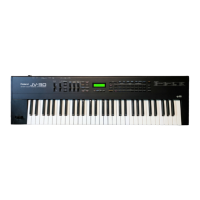How
to read a MIDI Implementation Chart
O
: MIDI data that can be transmitted or received.
X
: MIDI
data
that cannot
be
transmitted or received.
•
Basic Channel
The MIDI channel for
transmitting
(or
receiving) MIDI
data
can
be
specified
over
this
range. The MIDI channel setting is
remembered
even when the power is turned off.
#Mode
Most recent keyboard use mode 3 (omni off,
poly).
Reception : MIDI data is
received only on the specified channels, and played polyphonicaily.
Transmission : Ail MIDI
data
is transmitted on the specified MIDI channel.
•
"Mode"
refers
to
MIDI Mode messages.
#Note Number
This is the range of
note numbers that can be transmitted (or received). Note number 60 is middle
C CC4).
•
Velocity
This is
the range over
which velocity can
be
transmitted Cor received) by Note On and Note Off messages.
•
Aftertouch
Key's : Polyphonic
Aftertouch
Ch's : Channel
Aftertouch
•
Pitch Bender
The
bender range setting of each Tone
determines the range of pitch change caused by Pitch Bender messages. When
set
to
0,
Pitch
Bender messages will be ignored.
•
Control
Change
This indicates the control
numbers that can be transmitted (or received), and what
they will control. For details, refer
to
the MIDI
implementation.
•
Program
Change
The
program numbers in the chart
indicate the actual data.CThis is one less than the Tone
program numbers.)
•
Exclusive
Exclusive message
reception can be turned
On/Off.
•
Common,
Real time
These MIDI messages are used to
synchronize
sequencers and rhythm machines. The JV-30 does not use
these messages.
•
Aux messages
Mainly, these message
are of the type used to
prevent problems, such as Active Sensing
(Checks whether MIDI cable is
in proper
condition or not) ; and
All Notes Off (Message which terminates the
sounding of ail notes).
73

